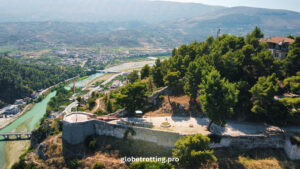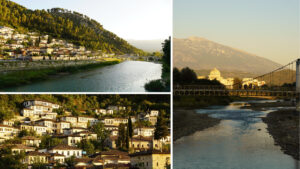This summer, I had the opportunity to revisit Berat, Albania, a city nestled in the heart of the country. Time Magazine recently recognized Berat as one of the “World’s Greatest Places of 2023,” making it the perfect time to rediscover my hometown. Born in Berat over three decades ago, this city has always held a special place in my heart, despite my twenty-five years of living abroad. Berat is renowned for its well-preserved Ottoman architecture, ancient history, and the charming atmosphere that seeps through every cobblestone street.
I visited Berat for my cousin’s wedding, which also provided me with the opportunity to reacquaint myself with the region’s natural splendor and partake in its local traditions and cuisine. The historic center of the city, known as the “Mangalem Quarter” and the “Gorica Quarter,” is a UNESCO World Heritage Site. The downtown area has undergone extensive reconstruction, making Berat a magnetic attraction for tourists. The city boasts a magnificent castle, one of the few inhabitable ones globally, as well as beautifully preserved Ottoman-era houses encircling the castle. The picturesque Osum River flows through the city, meeting the ancient stone Gorica Bridge, with the Shpirag and Tomorr mountains providing a breathtaking backdrop.
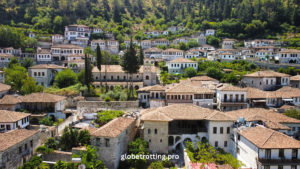
Growing up in Berat, I was captivated by the folklore that narrated the tale of two brothers in love with the same girl. Legend has it that Tomorr and Shpirag, the two brothers, fought over a girl named Osum. The fierce battle between them resulted in their tragic demise; with his sword, Tomorr cut Shpirag into pieces, while Shpirag hit Tomorr with cannons blowing holes in his body. Today, if you gaze upon these two mountains, you can see the scars of their battle etched into the landscape: Tomorr’s perforated summit and Shpirag’s grooved mountain terrain. The story goes that Osum, upon hearing the news, wept so profusely that her tears formed the Osum River, which now flows between the Tomorr and Shpirag mountains and divides the neighborhoods of Mangalem and Gorica in Berat.
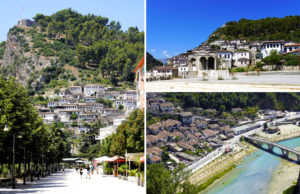
Beratino Hotel
We stayed at Beratino Hotel, an exquisite boutique hotel nestled beneath the ancient citadel’s ruins. This charming stone-walled haven offers guests a glimpse into Ottoman architectural splendor. Our enchanting deluxe double room with a ceiling adorned with intricate wood paneling and ottoman style furniture evoked the ambiance of the 14th century. It also had a private balcony, where we treated ourselves to a breathtaking panorama of the Gorica neighbourhood and Osum River that encapsulate the essence of this historic city. The hotel offered easy access to most attractions and ample free parking nearby.
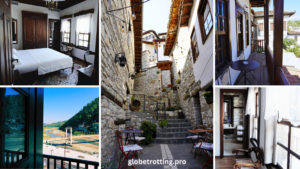
Berat is often referred to as the “City of a Thousand Windows” due to its unique architecture. These white Ottoman houses, known as “kullas,” are adorned with large windows, defining the city’s distinct character. It was a novel experience for me to find myself behind one of those iconic windows, allowing me to see the city from both a tourist’s and a local’s perspective. I couldn’t help but wonder what it must be like to wake up to such a view, imagining the daily life of those who grew up in those very houses.
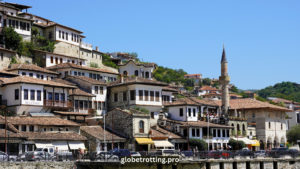
Berat Castle
Our visit to Berat Castle, also known as the Berat Fortress or ‘Kala,’ was one of the highlights of our trip. This iconic landmark, dating back to the Illyrians, has a history spanning over 2,400 years. Over the centuries, it was expanded and renovated by various rulers, including the Romans, Byzantines, and Ottomans. The castle served as both a defensive stronghold and a residential area.
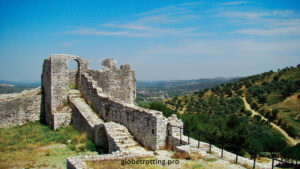
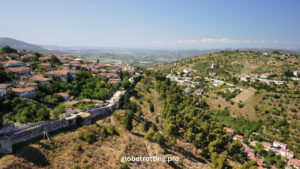
Inside the castle, narrow cobbled streets wind through stone houses, many still inhabited by locals. These Ottoman-era structures feature white stone walls, wooden balconies, and large windows, preserving the city’s unique architectural style. While strolling around the castle, we also came across local merchants showcasing their wares, which included rugs and traditional clothing, against the backdrop of stone-wall buildings.
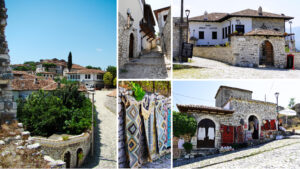
Our tour culminated at the Castle’s observatory area, or Tabe, where we absorbed panoramic views of the city and the majestic Osum River below. Berat Castle stands as a testament to the city’s rich history and architectural significance, offering travelers an opportunity to delve into Albania’s cultural heritage and immerse themselves in the allure of this ancient fortress.
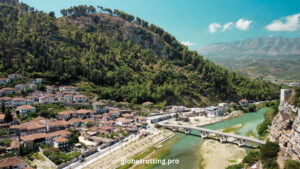
Following a quick stop at Shtëpia e Kafes Gimi, a traditional café near our hotel, we embarked on a culinary journey at Zonja Gjena, a restaurant boasting Ottoman-style architecture and traditional cuisine. Here, we reconnected with old friends over local delicacies, savoring familiar flavors that transported me back to my childhood. As the sun set, we marveled at the picturesque Gorica Bridge and the golden glow it cast upon the Osum River, visible from our hotel balcony.
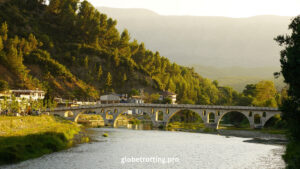
Reconnecting with the Past
My cousin’s wedding was a blend of tradition and modernity, held in a venue reminiscent of Roman architecture with colorful fountains. I reunited with extended family, sharing stories and laughter while relishing the delicious local cuisine. Albanian weddings often span several days, with the bride in her bridal attire throughout. The festivities are divided between the bride and groom’s families, with each side attending the other’s celebratory gatherings.
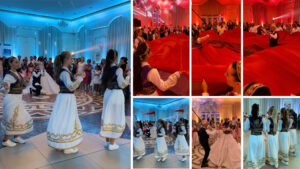
The dancefloor was alive with family and friends participating in the traditional Albanian wedding dance, the “Valle.” This group dance, performed in a circle or line formation, involves energetic footwork, graceful hand movements, and lively rhythms. We also enjoyed performances by professional dancers and witnessed the bride and groom’s dance in traditional attire. We departed from the wedding at dawn, even though the celebrations were still in full swing.

The following morning, we bid farewell to our hotel, taking a leisurely stroll along the riverbanks before heading to the Osum Canyons to experience Albania’s pristine wilderness and raw beauty. The weather was stunning heightening the vibrancy and richness of the surrounding scenery.
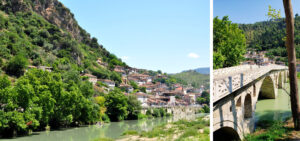
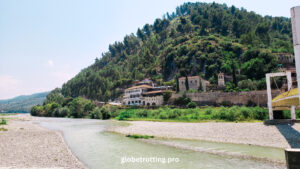
Osum Canyon
Located approximately 1.5 hours by car from Berat, the Osum Canyon, also known as the Osum Gorge, is a natural wonder. The canyon walls, reaching heights of up to 100 meters, showcase unique limestone formations sculpted through centuries of erosion. Osum River, the second-longest river in Albania, meanders through the canyons, creating a picturesque and narrow gorge. We tried to book kayaking in the river with the Albania Rafting Group but we were told that kayaking tours end after June as the water level drops and picks up again in the fall. Instead they offer hiking tours, but we chose to do something less labour-intensive.
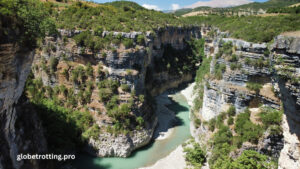
We first stopped at Vrima e Nuses, meaning the Bride’s Hole. This location is steeped in an ancient tradition involving a reluctant bride seeking refuge within the confines of this cavern, determined not to wed against her will. As time passed, this unique site became renowned as the “Bride’s Hollow” and started attracting new brides who sought fertility blessings. They would enter the rocky grotto fully adorned in bridal attire, subsequently disrobing and reattiring on the other side. Following this ritual, they would return home with newfound peace, believing their desires were now granted. While some may question the legend’s validity, the site provides a sheltered vantage point, particularly vital during the scorching summer months, allowing one to relish the breathtaking canyon views.
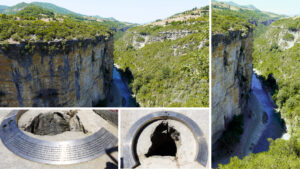
We proceeded to the Osum Canyon Bridge viewing point to indulge in more unparalleled vistas of the canyons, and here we decided to unleash our drone – for the final time, as fate would have it. We managed to capture some remarkable shots and videos beneath the nearby bridges, but eventually, we dared our drone beyond its limits. In an attempt to execute an emergency landing, our drone veered sideways, eventually taking an unintended plunge into a tree, losing its balance, and coming to rest on the cliffs in an indeterminate location. It was a regrettable farewell to our drone, yet the silver lining lay in the realization that our content remained safely stored on the DJI App, albeit at a lower quality. With a tinge of sadness for our lost companion but also with a sense of relief, we journeyed back to Berat for a swift luncheon before resuming our adventures in northern Albania.

Tradita e Beratit
With no reservation in place, we decided to test our luck at Tradita e Beratit – Hotel Restaurant, which is one of the most popular spots in Berat. Although we arrived when dinner was still a couple of hours away, the owners made an effort to accommodate us. First, they took us around the property on a private tour describing to us the restoration process and the hidden spots they uncovered. The property has been family-owned for many generations, but the restoration was completed recently having started during Covid-19.
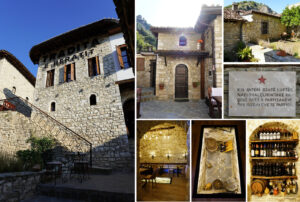
In the course of this restoration project, an exciting revelation unfolded as the restorers stumbled upon an ancient stone wall and a concealed doorway behind a faux wall. The entire restoration endeavor was meticulously geared toward preserving the house’s historical essence. This particular wall was erected in 1850, reinforced with wooden supports, following the aftermath of a significant earthquake that had ravaged the foundation. Notably, the house was constructed in a time predating the advent of electricity, evident in the strategically placed alcoves in the walls designed for the placement of candles.
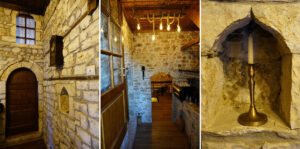
Furthermore, our visit granted us the privilege of admiring the magnificent panorama of the age-old Gorica Bridge, as we were graciously granted access to one of the rooms, which offered an exquisite view of the traditional rooftops of Gorica from the window on the upper floor.
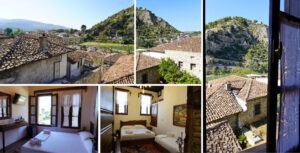
Following our exploration, we proceeded to the outdoor terrace, eager to embark on a culinary journey immersed in local flavors. Entrusting our meal choices entirely to the capable hands of our hosts, we were treated to a delectable spread of traditional dishes on the open-air patio. Our feast included “Pispilit,” a delightful cornbread stuffed with leeks and feta cheese, alongside stuffed eggplants and peppers. We savored “Qofte,” flavorful meatballs, and indulged in “Byrek,” an assortment of savory pies. The highlight of the meal was the cornbread, served with an array of cheeses and green olives, so irresistibly delicious that it momentarily made me forget my resolve to avoid carbs. Our culinary adventure continued with “Fergese,” eggs cooked in a luscious tomato sauce with peppers, and concluded on a sweet note with “Kasate,” a parfait-like ice cream. Each bite transported me back to the cherished flavors of my childhood. To ensure a safe journey ahead, we refrained from alcohol, including the tempting Albanian wine or the renowned local spirit, raki.
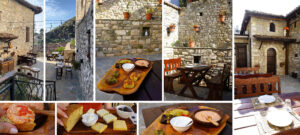
A standout feature of a Berat visit lies in immersing yourself in the warm hospitality of its residents. Referred to as “Beratasi,” the locals are celebrated for their amiable disposition and eagerness to impart their cultural heritage and traditions to guests. As our meal concluded, we had the pleasure of meeting the hostess responsible for curating the delightful menu. She graciously offered insights into her life in the city, a narrative my parents, who had spent most of their lives in Berat, could readily connect with. This encounter seamlessly integrated us into the local ambiance, forging a sense of belonging within the community.

Overall, Berat is a city that captures the essence of Albania’s rich history and natural beauty. The next time we visit Berat, we will make sure to visit the Ethnographic Museum and Onufri Museum, which house a remarkable collection of art and artifacts showcasing Berat’s cultural heritage. Whether you’re a history enthusiast, an architecture lover, or simply someone seeking an authentic cultural experience, Berat has something to offer. Plan your visit to this hidden gem and immerse yourself in the charm of Berat, a place where time seems to stand still. Albania’s best-kept secret awaits your discovery.


